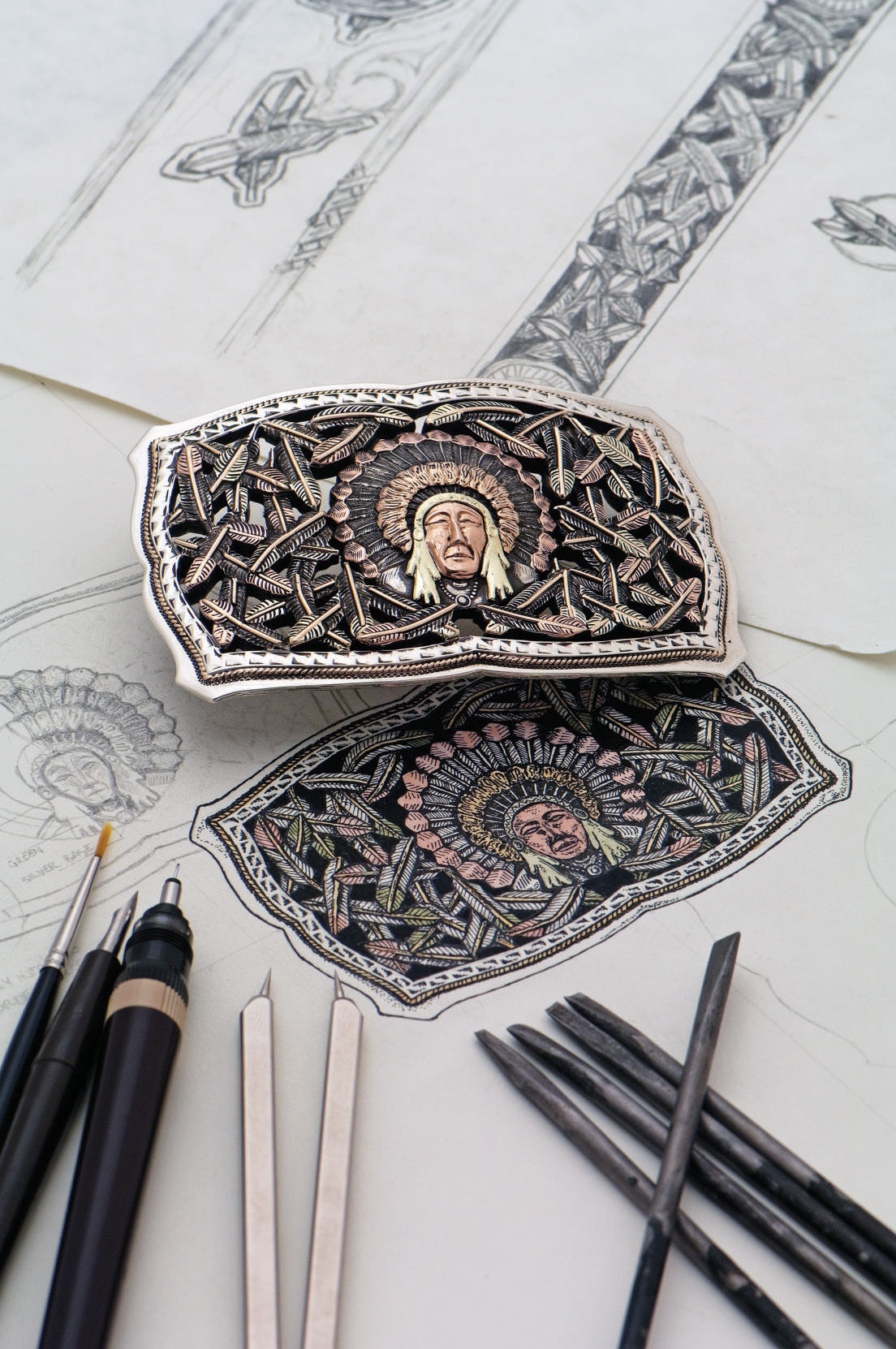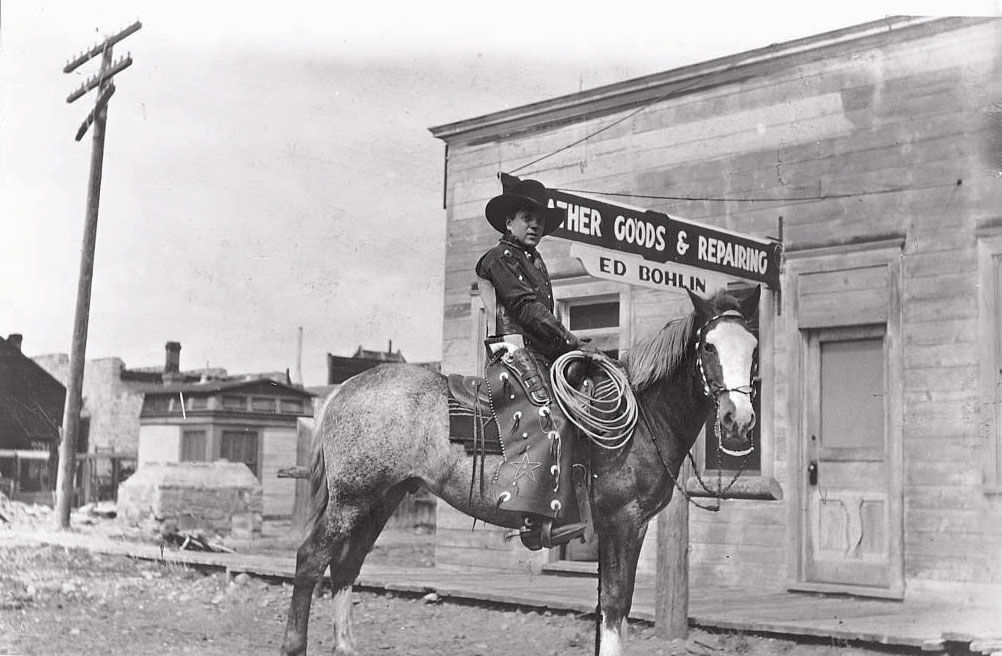“It’s the High Class Merchandise that Really Counts.”
The Bohlin brand is as iconic as the famed western stars that wore it. The late actor Richard Farnsworth sported a recognizable gold steer-head Bohlin buckle for decades, the engraving and edges worn smooth from years of daily wear, rodeo riding, and stunt work. When the Lone Ranger cried “Hi-yo, Silver!” as he rode to the rescue, both he and his white horse were equipped with Bohlin-made silver-mounted gear. Happily, The Bohlin Company that created these products in the 1940s continues today, maintaining original designs and traditions for fancy belt buckles and other jewelry in the mode of the company founder, all while innovating with new and exciting products to serve a contemporary audience.
Despite his cowboy credentials, when Ed Bohlin spoke there was the unmistakable residue of a Swedish accent that gave away his origins. He left the country of his birth when he was only 15 years old, arriving in New York in 1910 and immediately heading West, where by 1912 he was punching cattle in Montana. Four years later he was in Cody, Wyoming, driving a stagecoach, working at area ranches, and learning to do leatherwork. He soon married and had a daughter, Lillian, but his wife tragically died in the influenza epidemic of 1918, leaving Bohlin alone to provide and care for his daughter.
After some crude attempts at fashioning silver and copper buckles, Bohlin opened his own leather shop in 1920. But after a second marriage failed, Bohlin — who had become proficient with twirling a rope and shooting his Colt revolver — abandoned his business and joined a traveling Wild West show headed to the coast. It was just as well. His temper had gotten him into trouble with the law more than once, and it was time for him to move on.

Legend has it that during the show’s appearance at the Pantages Theatre in Los Angeles, Bohlin was approached by silent film cowboy Tom Mix, who wanted to purchase his handcrafted calf-skin jacket. Others soon recognized the flare in Bohlin’s style, and he began to appear as an extra in cowboy movies and started making tooled leather gear for stars like Mix, William S. Hart, and others. In 1922 he opened the Hollywood Novelty Leather Shop and scratched out a living by making special pieces for film star Buck Jones and his wife, Dell, who did stunt work. Major contracts to make leather outfits and harnesses for decidedly un-western films such as The Ten Commandments (1923) and Ben-Hur (1925) helped him to keep solvent.
Bohlin’s firm was formally organized in Hollywood in 1926 as Edward H. Bohlin Inc. The shop moved many times over the next 19 years as the founder skillfully promoted his wares and developed some of the most enduring designs for Western-styled buckles, saddles, and accessories. He became a master of brand promotion, publishing lavish catalogs, turning his shop into a gathering place for real and imagined cowboys, and joining organizations like the exclusive men’s equestrian group, the Rancheros Visitadores, whose members then bought and displayed his products.
Bohlin’s ever-expanding Hollywood associations included cowboy detective Charlie Siringo and artist Charlie Russell. He collaborated with Al Furstnow’s saddlery company, which was based in Montana but had set up a satellite shop in Hollywood, adding luxurious silver and gold embellishments to a saddle for Col. Tim McCoy, former Wyoming cowboy and first-rank cowboy movie star. Bohlin’s buckles, spurs, scarf slides, and jewelry could be spotted on Jackie Cooper, Clark Gable, John Wayne, Barbara Stanwyck, Clara Bow (the “It Girl” of the day), and scores more.
With the proliferation of low-budget western films, a new flock of performers took on the accessories of the Bohlin shop. Hopalong Cassidy (William Boyd), the Lone Ranger (Clayton Moore and John Hart), Roy Rogers, Ray “Crash” Corrigan, The Cisco Kid (Duncan Renaldo), Pancho (Leo Carrillo), Ken Maynard, and more adopted Bohlin gear for both performances and personal wear.
Even in the middle of the Great Depression, The Bohlin Company flourished, in large part thanks to the still-wealthy customers who rode in Pasadena’s Tournament of Roses Parade. Fancy silver-mounted horse gear had been used to show off finely bred horses and the gentry of California since the 1800s, and well-known Hispanic pioneer families such as the Sepulvedas and Yorbas continued to use Bohlin gear to display their prized equines well into the next century. Bohlin himself claimed to have ridden in every parade from 1922 until 1973.
Around the world, especially with the advent of television, the annual broadcast of the Rose Parade reinforced a clear image of elegant equestrian riders. The Los Angeles County Sheriff’s Silver Mounted Posse, the Long Beach Mounted Police, and many private horse groups predominantly used Bohlin gear. While the claim that The Bohlin Company made over 12,000 saddles cannot be reliably documented, the business flourished in the 1930s and ’40s.
A new Bohlin store opened on Highland Avenue in Hollywood in 1945; it was a one-stop shop with a full line of Western clothing, boots, gloves, hats, and anything else needed by a stylishly dressed rider or horse. Complete tack sets and riding outfits went to the Emperor of Japan, South American oil magnates, and European royalty. Bohlin-made prize buckles were awarded at rodeos in California, Colorado, and beyond, and riders from Kansas City horse shows to Indianapolis Shriner parades to Central Park riding clubs all sported Bohlin gear.

By the 1960s business began to decline, so Bohlin diversified once again, developing new products ranging from a peculiar iron camping stove to aluminum rifle cases. Inspired by his hero Charlie Russell, he turned his own hand toward bronze sculptures of Western wildlife. But the greatest creative endeavors of his waning years took him back to the beginning, designing some of the most elegant buckles and saddles in the Highland shop’s history for loyal customers, as well as for himself.
Bohlin designed solid gold buckles set with diamonds, rubies, and sapphires for Gene Autry and businessman Adolph Weinberg, while featured in the center of the shop, shown off in a maple-trimmed glass case, was The Big Saddle, Bohlin’s personal rig that reportedly took 14 years to make. Filigreed tooled leather is set off with corner plates and conchos made of sterling silver with three-color gold chased figures of rodeo performers and wildlife of the Pacific slope. Scenes of cowboys on bucking horses are taken directly from the art of Charlie Russell, while the cantle, pommel, and nose bands of the bridle are beautifully covered with chased nouveau designs and Indian heads with full-feathered headdresses.
The Bohlin Company changed hands many times beginning in 1980. Rumors of its demise revolved around the misguided actions of some owners; meanwhile others valiantly worked to maintain the standards of the firm. Despite (or because of) the uncertainty of the company’s future, prices for vintage Bohlin gear at public auctions escalated. In 1996, the Autry Museum of Western Heritage staged a 5,000-square-foot exhibition of the most famous Bohlin gear and published this writer’s book Saddlemaker to the Stars: The Leather and Silver Art of Edward H. Bohlin. The Big Saddle bought and donated by Gene Autry himself was the star of the show.
In March of 2000, Dave Marold, a former promoter of Cartier and Michel Jordi products, purchased The Bohlin Company with a group of investors. Marold is a modest man and a genuine advocate not just for the products of the company but for the young professionals who manage the firm and create its signature designs. While he moved the company from California to Dallas, Texas, he is quick to point out that the firm will always be identified as Bohlin of Hollywood. He is equally quick to note that the spirit of Ed Bohlin is to be found in every new piece, and that tradition is important to the line while innovation is a part of everything coming from the shop.
The days are past for printed Bohlin catalogs, but an interactive website and strong Facebook presence make viewing and ordering easy. You can see Bohlin products at the National Finals Rodeo, at the company showroom in Dallas, and at select retail outlets. For a number of years Bohlin has done a special presentation buckle featuring an artist’s palette and paintbrushes for the Autry Museum of the American West’s Masters of the American West show and sale, and in 2010 the company created a presentation buckle for the winning driver in the Indianapolis 500 race.
As Marold points out, the key to Bohlin’s success today is in large part due “to recognizing the value of the brand, that it is as strong a brand as Cartier, only it is American, it is an American story.” The quality of the products, which include fine watches, buckles, and jewelry, is based not just on the tradition and reputation of the firm but also on materials and craftsmanship. The thickness and purity of gold and silver used have been increased, and the best young talent works to manage sales, design, and production.
As The Bohlin Company approaches its 100th anniversary in 2020, the brand is secure, as much a part of the West as the men and women who wore it. Ed Bohlin would approve of the ongoing efforts of the spirited group of young talent now leading the Bohlin firm. A temperamental taskmaster, his motto still applies: “It’s the High Class Merchandise that Really Counts."
James H. Nottage’s book Saddlemaker to the Stars: The Leather and Silver Art of Edward H. Bohlin is available from www.amazon.com.
From the November/December 2010 issue.














